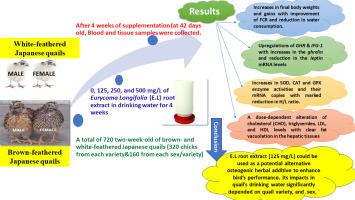Effect of water supplementation with Eurycoma longifolia (Tongkat Ali) root extract on growth performance, carcass characteristics, antioxidant responses, and gene expression in brown and white Japanese quails
IF 1.9
3区 农林科学
Q2 AGRICULTURE, DAIRY & ANIMAL SCIENCE
引用次数: 0
Abstract
The impact of varying doses of water-soluble E. longifolia root extract was evaluated on growth performance, blood biochemistry, antioxidant enzymes, histology, and expression of some related genes in brown- and white-feathered Japanese quails. Seven hundred and twenty 2-wk old quails (360 brown- and 360 white-feathered quails, 180 males and 180 females each) were randomly assigned to 8 treatments with 3 replicates having 30 quails per replicate (15 females and 15 males from the same quail’s variety). The E. longifolia was incorporated in drinking water at 0, 125, 250, and 500 mg E. longifolia/L for treatment 1, 2, 3, and 4, respectively. This experiment lasted for 4 wk. Drinking water with E. longifolia, especially at 125 mg E. longifolia/L increased body gains and feed consumption as well as gain-to-feed ratio (linear; quadratic, cubic, P < 0.05) with brown females, compared to brown males and both sex of white-feathered quails, displayed greater improvement. Growth-related genes: growth hormone receptors and insulin growth factor-1, and ghrelin mRNA concentrations were upregulated while leptin mRNA copies were reduced with E. longifolia (linear; quadratic, cubic, P < 0.001). Increasing the dose of E. longifolia reduced water consumption (linear, P < 0.001). The brown-feathered quails drank more water compared to the white-feathered ones, especially with increasing the E. longifolia supplementation rate (P = 0.004). E. longifolia also caused distinct improvement of quails’ immunity manifested by a reduced heterophils-to-lymphocytes ratio (quadratic, P = 0.005) and increases in the superoxide dismutase (cubic, P = 0.015), catalase and glutathione peroxidase enzyme activities and their mRNA copies (linear; quadratic, cubic, P < 0.001). Additionally, E. longifolia supplementation caused increases in cholesterol concentrations in white-feathered females and males and brown females while increased triglycerides concentrations, particularly at 125 mg/L in all quails except in brown female, E. longifolia reduced its concentration (quadratic, cubic, P < 0.05). Increasing supplementation dose to 500 mg E. longifolia/L lowered these concentrations compared to the lower doses. Incorporating E. longifolia also caused increases in the intestinal villi lengths (linear, P < 0.001; quadratic, P < 0.05) with fat vacuolation in hepatic tissue. Moreover, reduction in estrogen (linear, P < 0.001) and changes in testosterone concentrations (quadratic, P < 0.05) were measured with E. longifolia treatment. In conclusion, E. longifolia root extract could be used as a potential alternative osteogenic herbal additive to enhance bird’s performance. Its impacts in quail’s drinking water significantly depended on quail variety, and sex. `

补水对褐白日本鹌鹑生长性能、胴体特性、抗氧化反应和基因表达的影响
本试验研究了不同剂量的水溶长叶根提取物对褐羽和白羽日本鹌鹑生长性能、血液生化、抗氧化酶、组织学及相关基因表达的影响。选取722只2周龄鹌鹑(褐羽和白羽各360只,公、母各180只),随机分为8个处理,每个处理3个重复,每个重复30只鹌鹑(同一鹌鹑品种,公、母各15只)。在处理1、2、3和4时,分别以0、125、250和500 mg长叶莲子/L加入饮用水中。试验期4周。与白羽鹌鹑的雄性和雄性相比,棕色雌鹌鹑的体增重、饲料消耗和料重比(线性、二次、三次,P < 0.05)均显著提高,特别是在125 mg /L的浓度下。生长相关基因:生长激素受体和胰岛素生长因子-1,以及ghrelin mRNA浓度上调,而瘦素mRNA拷贝数减少(线性;二次,三次,P < 0.001)。增加长叶莲子的剂量减少了水的消耗(线性,P < 0.001)。褐羽鹌鹑的饮水量明显高于白羽鹌鹑(P = 0.004)。长叶黄还能显著提高鹌鹑的免疫力,表现为降低嗜淋巴细胞比(二次,P = 0.005),提高超氧化物歧化酶(立方,P = 0.015)、过氧化氢酶和谷胱甘肽过氧化物酶活性及其mRNA拷贝数(线性,二次,立方,P < 0.001)。此外,白羽雌鹌鹑、雄性鹌鹑和棕色雌鹌鹑的胆固醇浓度升高,甘油三酯浓度升高,特别是在125 mg/L时,除棕色雌鹌鹑外,所有鹌鹑的甘油三酯浓度均降低(二次、三次,P = 0.05)。与较低剂量相比,将补充剂量增加到500 mg /L可降低这些浓度。加入长叶大肠杆菌也导致肠绒毛长度增加(线性,P < 0.001;二次,P < 0.05),肝组织脂肪空泡化。此外,还测量了长叶莲治疗后雌激素的降低(线性,P < 0.001)和睾酮浓度的变化(二次曲线,P < 0.05)。综上所述,龙叶提取物可作为一种潜在的替代成骨草药添加剂,提高禽类的生产性能。它对鹌鹑饮用水的影响主要取决于鹌鹑的种类和性别。`
本文章由计算机程序翻译,如有差异,请以英文原文为准。
求助全文
约1分钟内获得全文
求助全文
来源期刊

Livestock Science
农林科学-奶制品与动物科学
CiteScore
4.30
自引率
5.60%
发文量
237
审稿时长
3 months
期刊介绍:
Livestock Science promotes the sound development of the livestock sector by publishing original, peer-reviewed research and review articles covering all aspects of this broad field. The journal welcomes submissions on the avant-garde areas of animal genetics, breeding, growth, reproduction, nutrition, physiology, and behaviour in addition to genetic resources, welfare, ethics, health, management and production systems. The high-quality content of this journal reflects the truly international nature of this broad area of research.
 求助内容:
求助内容: 应助结果提醒方式:
应助结果提醒方式:


